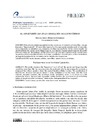Please use this identifier to cite or link to this item:
https://accedacris.ulpgc.es/handle/10553/70453
| DC Field | Value | Language |
|---|---|---|
| dc.contributor.author | Márquez Guerrero, Miguel Ángel | en_US |
| dc.date.accessioned | 2020-02-21T12:31:58Z | - |
| dc.date.available | 2020-02-21T12:31:58Z | - |
| dc.date.issued | 2017 | en_US |
| dc.identifier.issn | 2386-8635 | en_US |
| dc.identifier.uri | https://accedacris.ulpgc.es/handle/10553/70453 | - |
| dc.description.abstract | Este artículo estudia una unidad métrica mayor que el versículo del verso libre, a la que denomino “hiperversículo”. El verso libre innova la silva modernista introduciendo el versículo, verso compuesto de miembros que comparten el ritmo endecasilábico de los versos simples. La prosificación de los poemas en la última etapa de Juan Ramón Jiménez quedó como un desarrollo extremo y marginal. Sin embargo, el hiperversículo de los novísimos aparece en los sesenta como un puente entre el verso libre inicial y sus formas ‘prosificadas’. Por otra parte, el hiperversículo es un rasgo de la poética de los novísimos que los vincula a las vanguardias. | en_US |
| dc.description.abstract | This article examines the “hyperverse”, as I will call the metric unit longer than the typical free verse line. The free verse innovates the modernist silva by introducing the versículo, a compound line whose members share the general hendecasyllabic rhythm. The prosification of Juan Ramón Jiménez’s last poems meant a radical evolution of the free verse, but this move remained marginal. However, the hyperverse of the “novísimos” arises in the sixties as a link between the original free verse and its prosified variety. Besides, the hyperverse is a characterizing feature of the poetry of the “novísimos” which relates their generation to the vanguard. | en_US |
| dc.language | spa | en_US |
| dc.relation.ispartof | Philologica canariensia | en_US |
| dc.source | Philologica canariensia [ISSN 2386-8635], n. 23, p. 49-62 | en_US |
| dc.subject | 550510 Filología | en_US |
| dc.subject | 570107 Lengua y literatura | en_US |
| dc.subject.other | Novísimos | en_US |
| dc.subject.other | Teoría literaria | en_US |
| dc.subject.other | Métrica | en_US |
| dc.subject.other | Verso libre | en_US |
| dc.subject.other | Hiperversículo | en_US |
| dc.subject.other | Literary theory | en_US |
| dc.subject.other | Metrics | en_US |
| dc.subject.other | Free verse | en_US |
| dc.subject.other | Hyperverse | en_US |
| dc.title | El hiperversículo en la generación de los novísimos | en_US |
| dc.type | info:eu-repo/semantics/article | en_US |
| dc.type | Article | en_US |
| dc.identifier.doi | 10.20420/PhilCan.2017.14 8 | en_US |
| dc.investigacion | Artes y Humanidades | en_US |
| dc.type2 | Artículo | en_US |
| dc.identifier.ulpgc | Sí | es |
| dc.description.esci | ESCI | |
| dc.description.dialnetimpact | 0,0 | |
| dc.description.dialnetq | Q3 | |
| dc.description.dialnetd | D8 | |
| dc.description.erihplus | ERIH PLUS | |
| item.fulltext | Con texto completo | - |
| item.grantfulltext | open | - |
| Appears in Collections: | Artículos | |
Page view(s)
155
checked on Jun 14, 2025
Download(s)
109
checked on Jun 14, 2025
Google ScholarTM
Check
Altmetric
Share
Export metadata
Items in accedaCRIS are protected by copyright, with all rights reserved, unless otherwise indicated.
